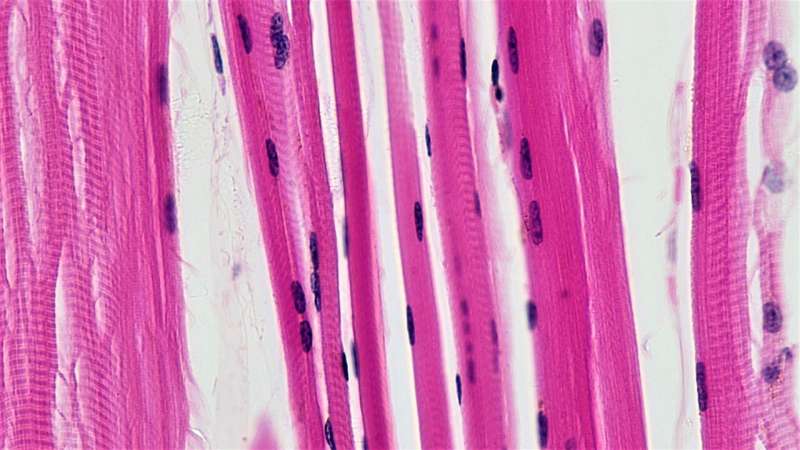This article has been reviewed according to Science X's editorial process and policies. Editors have highlighted the following attributes while ensuring the content's credibility:
fact-checked
trusted source
proofread
Experts assess promise of vamorolone to treat Duchenne muscular dystrophy

The drug vamorolone (Agamree) has been hailed as a promising new drug to treat Duchenne muscular dystrophy (DMD). It has recently been approved for clinical use in the United States by the Food and Drug Administration (FDA) and in the European Union by the European Medicines Agency (EMA).
A Commentary in the Journal of Neuromuscular Diseases presents an independent, unbiased assessment of the drug's merits, outcomes of pre-clinical and clinical trials, and other findings based on reports in the scientific literature.
Authors Miranda D. Grounds, Ph.D., and Erin M. Lloyd, Ph.D., both of the Department of Anatomy, Physiology and Human Biology, School of Human Sciences, The University of Western Australia, conclude that vamorolone (also known as VBP15) is a promising steroid treatment for DMD, with similar efficacy and evidence for some reduced adverse side effects compared with traditional glucocorticoid steroid treatments, such as prednisone. However, certain issues require clarification and further investigation.
Drawing on more than 40 years of research in skeletal muscle cell biology with a view towards clinical translation to treat neuromuscular disorders including DMD, Professor Grounds explains, "An independent assessment of the research around vamorolone for DMD treatment is of importance for the wide DMD community, which includes young patients with DMD and their families, associated clinicians, scientists, researchers, and other experts around the world. There is an urgent need for therapies and superior drugs to treat this lethal childhood disease. Vamorolone is also of potential interest for other muscular dystrophies."
DMD is an inherited X chromosome-linked muscle disorder, manifesting in young children and predominantly affecting males, resulting in rapid loss of muscle mass and of function of most skeletal muscles. Symptoms are evident around 2–3 years of age, and many boys become wheelchair dependent around 10–12 years old.
Further complications include progressive degeneration of muscles, scoliosis, contractures, and increasing respiratory and cardiac complications with age. However, with modern interventions and care, the lifespan of patients with DMD can be extended to about 20–40 years. In addition, new gene therapies are in development.
Glucocorticoids such as prednisone and deflazacort, that have broad targets, including the inflammatory system, are considered the standard of care for DMD because they slow down disease progression, but long-term use can result in severe adverse side effects. Vamorolone was designed as a unique dissociative steroidal anti-inflammatory drug to retain efficacy and minimize these adverse effects.
The analysis for this Commentary entailed a thorough evaluation of documented results from clinical and pre-clinical studies of vamorolone, as well as an in-depth assessment of completed and ongoing clinical trials. The authors found that vamorolone has similar efficacy to prednisone in terms of improved muscle function and reduced inflammation, with some reduced adverse side effects related to growth and bone quality (compared to those from prednisone and deflazacort), but adverse effects such as adrenal suppression were still evident and influenced by dose.
"In the clinical trial results, we noted that there have been surprisingly few direct comparisons of vamorolone treatment with prednisone and deflazacort, since many of the early clinical trials mainly compared the effects of vamorolone with data for age-matched untreated (or placebo) DMD boys," says Dr. Lloyd. "Only one completed trial compared a relatively short-term (6-month) vamorolone treatment with prednisone treatment. To date, vamorolone has not been directly compared with deflazacort."
Based on their in-depth analysis of pre-clinical trial results, the authors identified issues that would benefit from further clarification:
- Does vamorolone protect (or reduce) dystrophic muscles from necrosis? Muscle necrosis is the central problem in the breakdown of skeletal muscles in DMD, and vamorolone's direct impact on necrosis is not clearly demonstrated in the current body of research.
- The observation that vamorolone improves membrane repair following experimental injury piques interest. However, it is hard to extrapolate these observations to the realistic in vivo situation of intrinsic muscle damage in DMD (and other muscular dystrophies such as dysferlinopathy). Further studies to interrogate the precise in vivo mechanisms behind these observations are welcomed for DMD and other muscular dystrophies.
The authors note that most of the clinical and pre-clinical studies have been conducted by large international networks of collaborators, and advise, "For future pre-clinical studies, it is desirable for some independent researchers to conduct investigations to validate the main findings of the existing body of work and provide further insights into the mechanisms of action of vamorolone."
Professor Grounds and Dr. Lloyd add, "An important consideration is the likely cost of vamorolone for clinical use, compared with existing drugs. While it is recognized that drug development is a very expensive process, extraordinarily high prices for consumers present difficulties for patient access to treatments and for global health systems. This issue and others require balanced critical discussion by the wider community."
More information: Miranda D. Grounds et al, Considering the Promise of Vamorolone for Treating Duchenne Muscular Dystrophy, Journal of Neuromuscular Diseases (2023). DOI: 10.3233/JND-230161



















